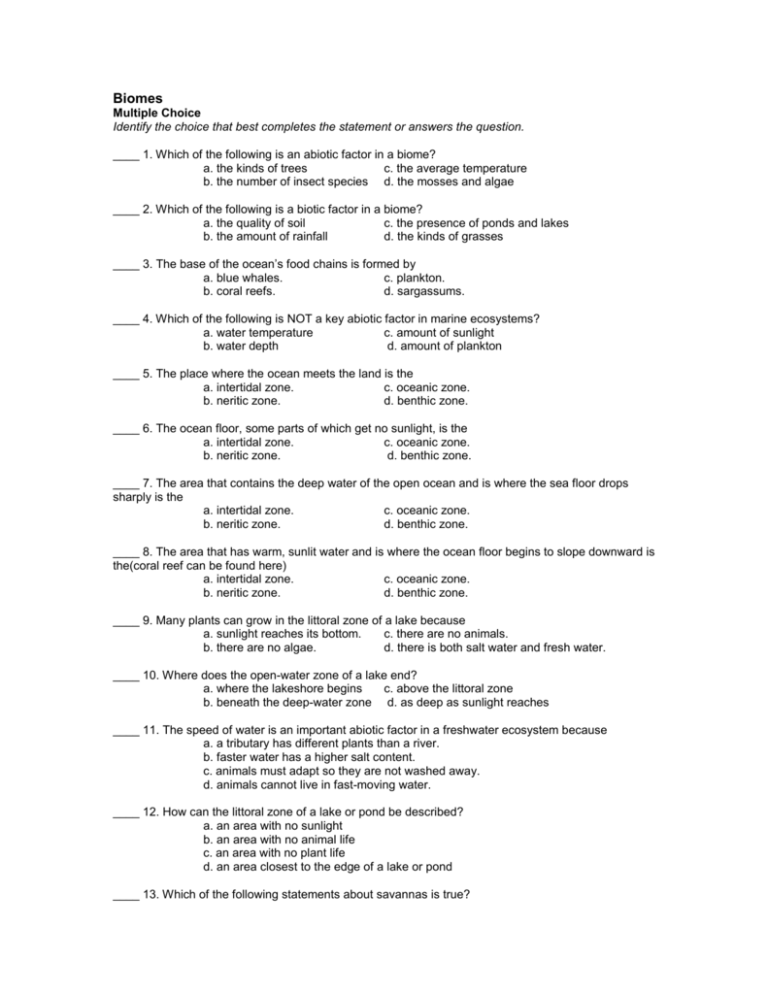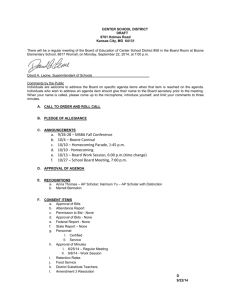pretest_posttest
advertisement

Biomes Multiple Choice Identify the choice that best completes the statement or answers the question. ____ 1. Which of the following is an abiotic factor in a biome? a. the kinds of trees c. the average temperature b. the number of insect species d. the mosses and algae ____ 2. Which of the following is a biotic factor in a biome? a. the quality of soil c. the presence of ponds and lakes b. the amount of rainfall d. the kinds of grasses ____ 3. The base of the ocean’s food chains is formed by a. blue whales. c. plankton. b. coral reefs. d. sargassums. ____ 4. Which of the following is NOT a key abiotic factor in marine ecosystems? a. water temperature c. amount of sunlight b. water depth d. amount of plankton ____ 5. The place where the ocean meets the land is the a. intertidal zone. c. oceanic zone. b. neritic zone. d. benthic zone. ____ 6. The ocean floor, some parts of which get no sunlight, is the a. intertidal zone. c. oceanic zone. b. neritic zone. d. benthic zone. ____ 7. The area that contains the deep water of the open ocean and is where the sea floor drops sharply is the a. intertidal zone. c. oceanic zone. b. neritic zone. d. benthic zone. ____ 8. The area that has warm, sunlit water and is where the ocean floor begins to slope downward is the(coral reef can be found here) a. intertidal zone. c. oceanic zone. b. neritic zone. d. benthic zone. ____ 9. Many plants can grow in the littoral zone of a lake because a. sunlight reaches its bottom. c. there are no animals. b. there are no algae. d. there is both salt water and fresh water. ____ 10. Where does the open-water zone of a lake end? a. where the lakeshore begins c. above the littoral zone b. beneath the deep-water zone d. as deep as sunlight reaches ____ 11. The speed of water is an important abiotic factor in a freshwater ecosystem because a. a tributary has different plants than a river. b. faster water has a higher salt content. c. animals must adapt so they are not washed away. d. animals cannot live in fast-moving water. ____ 12. How can the littoral zone of a lake or pond be described? a. an area with no sunlight b. an area with no animal life c. an area with no plant life d. an area closest to the edge of a lake or pond ____ 13. Which of the following statements about savannas is true? a. During the wet season, savannas receive little rain. b. Savanna inhabitants include large herbivores. c. Savannas are characterized by steep mountains. d. Savannas are rainy year-round. ____ 14. The most biologically diverse biome is the a. swamp. c. temperate grassland. b. tundra. d. tropical rain forest. ____ 15. What is permafrost? a. dry desert soil b. muddy soil c. ice on the tundra d. soil that is always frozen ____ 16. Which of the following is a key abiotic factor in rivers? a. number of fish c. amount of salt b. speed of water d. how animals adapt ____ 17. How does a swamp differ from a marsh? a. A swamp has salt water. c. A swamp has many birds. b. A swamp has trees. d. A swamp has very wet soil. ____ 18. Which ocean temperature zone is the warmest? a. neritic zone c. deep zone b. abyss d. littoral zone Completion Complete each statement. Use the terms from the following list to complete the sentences below. A. Savanna B. desert C. deciduous forest D. tundra 19. A dromedary is an animal that can travel for many days without drinking water. You would expect to find the dromedary in a ____________________ biome. 20. The hare curls up to stay warm. It has a short tail and ears that hold in body heat. The hare would most likely live in a ____________________ biome. 21. The white-tailed deer has a spotted coat that helps it blend in with trees. This deer would most likely be found in a ____________________ biome. Use the terms from the following list to complete the sentences below. A. deciduous B. conifer 22. A redwood is a tree that has cones and leaves shaped like needles. Therefore, a redwood is a ____________________. 23. The sugar maple tree has leaves that turn yellow, orange, and red in fall. Therefore, a sugar maple is a ____________________ tree. Use the terms from the following list to complete the sentences below. A. taiga B. tropical rain forest C. savanna D. tundra 24. You are in Africa. It is summer and dried grass covers the ground. You are likely in a ____________________. 25. It is winter. You are in a place with tall trees full of leaves in the shape of needles. It is 0°C. You are likely in a ____________________. 26. You are in a place with many trees that receives 500 cm of rainfall per year. You are likely in a ____________________. Matching Match the labels to the drawings. ____ 27. Oceanic zone: contains the deep water of the open ocean and animals such as whales and sharks ____ 28. Benthic zone: deepest parts get no sunlight; animals, such as crabs, have adapted to the deep, dark water ____ 29. Neritic zone: water is warm and receives a lot of sunlight; sea turtles and dolphins live here ____ 30. Intertidal zone: animals must adapt to crashing waves and exposure to air Biomes Answer Section MULTIPLE CHOICE 1. ANS: C OBJ: 1 & 2 2. ANS: D OBJ: 1 & 2 3. ANS: C OBJ: 5 & 6 4. ANS: D OBJ: 5 & 6 5. ANS: A OBJ: 5 & 6 6. ANS: D OBJ: 5 & 6 7. ANS: C OBJ: 5 & 6 8. ANS: B OBJ: 5 & 6 9. ANS: A OBJ: 7 & 8 10. ANS: D OBJ: 7 & 8 11. ANS: C OBJ: 7 & 8 12. ANS: D OBJ: 7 & 8 13. ANS: B OBJ: 3 & 4 14. ANS: D OBJ: 3 & 4 15. ANS: D OBJ: 3 & 4 16. ANS: B OBJ: 7 & 8 17. ANS: B OBJ: 7 & 8 18. ANS: A OBJ: 5 & 6 COMPLETION 19. ANS: B OBJ: 3 & 4 20. ANS: D OBJ: 3 & 4 21. ANS: C OBJ: 3 & 4 22. ANS: B OBJ: 3 & 4 23. ANS: A OBJ: 3 & 4 24. ANS: C OBJ: 3 & 4 25. ANS: D OBJ: 3 & 4 26. ANS: B OBJ: 3 & 4 MATCHING 27. ANS: C OBJ: 5 & 6 28. ANS: D OBJ: 5 & 6 29. ANS: B OBJ: 5 & 6 30. ANS: A OBJ: 5 & 6









